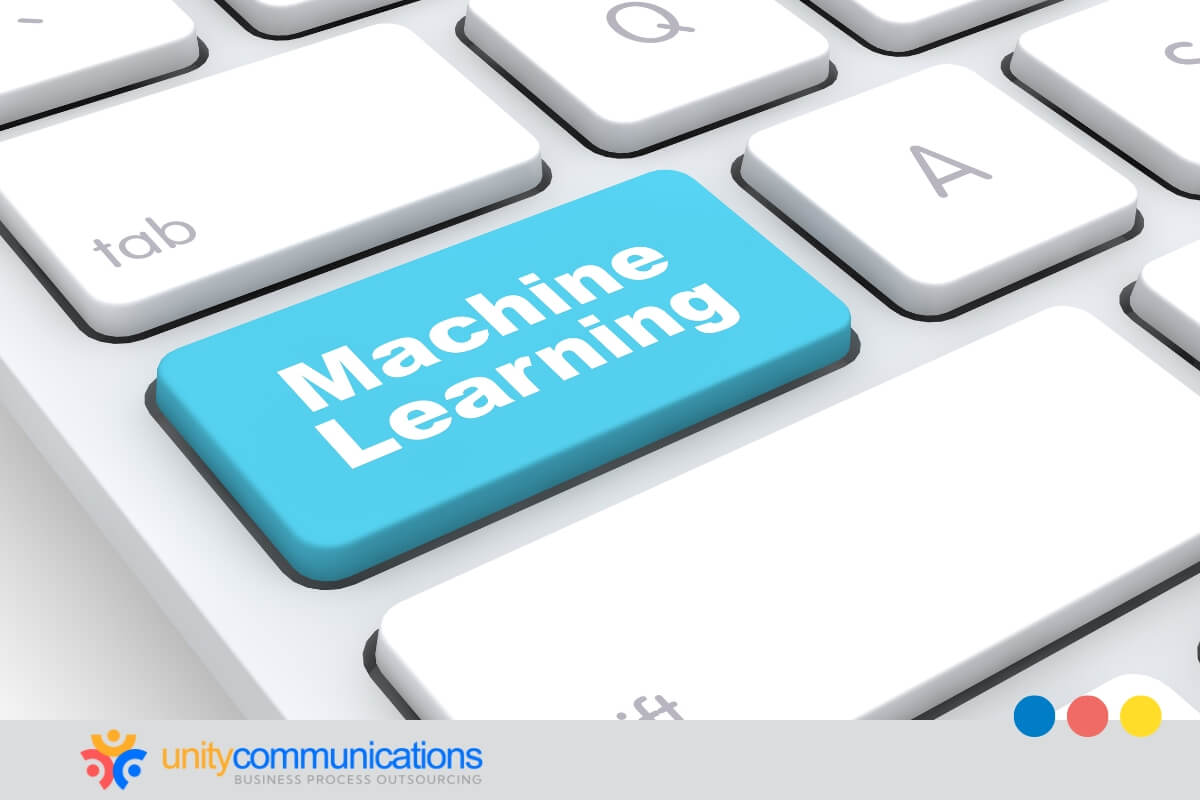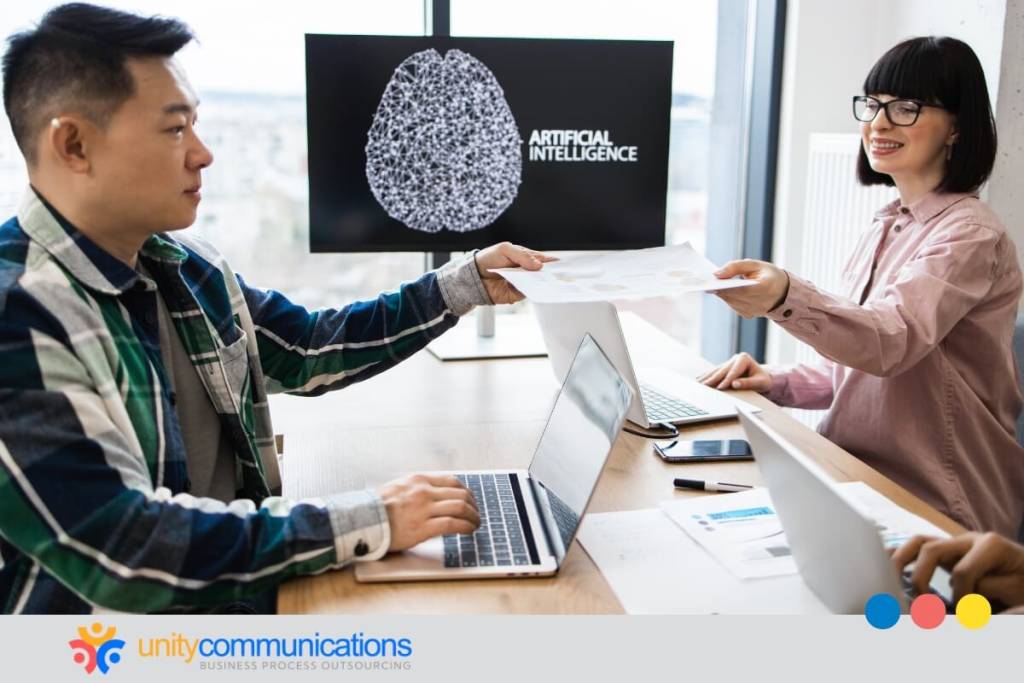Table of Contents
Artificial intelligence (AI) reinvents how companies handle complex operations and optimize efficiency. To keep up, leaders need to understand what an AI agent is and how it can transform business process outsourcing (BPO) and internal workflows.
AI agents go beyond automation. They improve customer engagement, streamline finance and HR processes, and deliver real-time insights that drive smarter decisions.
In this guide, we’ll explain the definition of an AI agent, including how it works and where businesses use them. You’ll also learn the benefits, risks, and best practices for adoption to see how AI agents help boost accuracy, speed, and business performance.
Understanding what an AI agent is

What is an AI agent? The answer centers on independence. An AI agent can sense, process, and act within a business environment without constant human input. This makes it powerful for small- and medium-sized companies handling complex tasks.
By early 2025, research showed that about 71% of organizations consistently used generative AI, up from 65% in 2024. This growth signals agent-driven workflows move quickly from experiments into everyday business operations, boosting readiness for outsourcing opportunities.
As a business owner, understanding autonomy means seeing how AI agents act independently while staying aligned with set goals. Their role is not just about automation. They enhance decision-making, reduce labor-heavy work, and strengthen outsourcing partnerships, including back-office functions.
Today, 82% of companies report engaging with AI in some form. This shows the technology’s widespread value across industries and highlights why you must explore agents for customer engagement, data insights, and operations. Here are business-focused examples where AI autonomy adds measurable impact:
- Managing repetitive financial reporting tasks with minimal human intervention
- Coordinating supplier communications across time zones with real-time updates
- Enhancing human resources (HR) outsourcing through faster resume screening and candidate sorting
- Driving better insights in outsourced analytics by processing unstructured data quickly
Adoption is no longer optional but central to staying resilient. This level of independence allows AI agents to become reliable partners in outsourcing strategies, helping you cut costs while improving speed and accuracy.
Core components of AI agents: Building blocks of intelligence
To understand what an AI agent is, you should see the essential parts that make it function in real business settings. These building blocks allow agents to act independently within your company’s operational and outsourcing frameworks.
One foundation is data ingestion. AI agents rely on structured and unstructured data to deliver valuable outcomes. They tap into customer interactions, transaction logs, and even partner systems.
For outsourcing leaders, this matters because third-party teams can receive consistent insights without manually processing endless information. The next block is connectivity through tools and application programming interfaces (APIs).
Studies indicate that APIs now contribute 40% of company revenue in leading enterprises, showing their critical role for agents. This lets you deploy agents that link seamlessly into outsourced workflows.
Advantages include:
- Automating outsourced financial reconciliations with real-time accounting tools
- Linking customer service agents with customer relationship management (CRM) systems for faster resolution times
- Integrating supplier portals into outsourcing hubs for transparent global coordination
- Coordinating multilingual communication in outsourced support centers through AI-driven translation tools
Another essential layer is reasoning and decision-making. Beyond automation, AI agents analyze data to support intelligent outcomes. When paired with outsourcing partners, they strengthen decision flows by reducing manual back-and-forth.
This combination of data, connectivity, and reasoning helps define what an AI agent is in practice for modern enterprises. Together, these building blocks set the stage for outsourcing models that depend on reliable, independent, and connected agents that operate at speed and scale.
Five types of AI agents and their business applications
To understand what an AI agent is, you should see the five main types that shape outsourcing operations. Each expands business capabilities and supports service providers, helping agents align with specific business goals.
The five core types include:
1. Reactive agents
These respond directly to inputs without memory. They work well for repetitive customer inquiries in BPO call center companies. A reactive agent can instantly provide billing details or shipping status, boosting satisfaction while freeing human agents to handle more complex concerns.
2. Model-based agents
These use memory to guide decisions. For outsourced finance or HR teams, they recall employee records and transaction histories. This reduces manual data searches, speeds payroll, and shortens expense processing, driving faster turnaround in shared service centers.
3. Goal-based agents
These make decisions and take actions based on achieving objectives. In outsourced logistics, they optimize delivery routes by analyzing weather and traffic data. Their focus on outcomes cuts costs and delays, strengthening supply chain performance across global operations.
4. Utility-based agents
These compare outcomes and select those with the most value. They help evaluate suppliers by balancing cost, quality, and timelines in procurement outsourcing. Their evaluations strengthen vendor partnerships and improve contracts and profit margins.
5. Learning agents
These adapt over time through data and feedback. In fraud detection outsourcing, they flag new suspicious patterns as threats shift. In customer engagement, they refine personalized recommendations, giving third-party marketing teams more effective campaigns and higher conversion rates.
Together, the five types define how AI agents operate in practice. They are reliable partners that drive efficiency and more intelligent decision-making across outsourcing models.
How AI agents use reasoning and heuristics to make smarter decisions

To understand what an AI agent is, you should know how reasoning and heuristics shape decision-making. Reasoning processes large data sets, while heuristics act as simplified rules or shortcuts that help agents decide quickly without reviewing every possible outcome.
Both elements matter in outsourcing environments:
- Reasoning supports operational accuracy by analyzing structured and unstructured information from enterprise data.
- Heuristics accelerate outcomes by applying rules based on past results.
This means decisions can be smarter and faster, supporting business continuity without unnecessary manual review.
Performance benchmarks highlight this capability. The AI Index 2025 reports year-over-year gains of 48.9 points on graduate-level Google-proof question answering (GPQA) and 67.3 points on software engineering (SWE) benchmark.
Outsourced workflows now benefit from measurable reasoning power and consistency improvements across complex enterprise tasks. The role of machine learning (ML) in BPO strengthens this decision logic by refining how heuristics adapt.
ML continuously improves outcomes by analyzing new inputs, teaching agents to respond more accurately with every interaction. Outsourcing teams benefit because agents improve their reasoning power while reducing repetitive workloads. You can see how this applies in practice:
- Automating financial reconciliations with updated decision rules from historical data
- Predicting customer needs in outsourced customer experience (CX) centers for faster resolutions
- Improving HR compliance workflows through adaptive reasoning models
- Supporting IT operations with decision shortcuts that cut downtime
- Enhancing procurement outsourcing with refined supplier decision frameworks
Reasoning, heuristics, and ML help external teams operate more clearly and confidently across business functions.
Memory architectures: Giving AI agents context and continuity
To understand what an AI agent is, you should explore how memory shapes performance. Memory architectures allow agents to recall past interactions, context, and rules to act more intelligently within outsourced environments. This matters when operations demand consistent and accurate outcomes.
Enterprises report that 90% struggle with fragmented data silos, which limit the quality of memory retrieval and weaken contextual responses. This shows why memory systems matter since they directly influence how outsourcing partners use agents to deliver reliable results for high-volume processes.
These architectures become powerful in outsourced workflows where continuity and historical insight are essential. Agents can recall facts and the sequence of prior actions, giving you more substantial support and reducing errors in decision cycles. Key benefits include:
- Preserving transaction context for outsourced finance teams to minimize repetitive back-and-forth
- Retaining conversation history in customer service hubs to provide smoother experiences
- Maintaining compliance records in outsourced HR or legal services for consistent governance
- Tracking supply chain events so logistics partners act with precise historical insight
At this stage, robotic process automation (RPA) intersects with outsourcing. It manages repetitive execution, while memory-equipped agents enhance workflows by adapting responses based on past performance. This combined approach highlights the broader impact of RPA on BPO, delivering scalable efficiency for BPO teams handling complex global operations.
These memory frameworks demonstrate that agents process current information and use accumulated context to refine outsourcing performance, which drives smarter growth across enterprise functions.
Multi-agent workflows: Coordinating enterprise tasks at scale
When you think about what an AI agent is, it helps to view this system as a unit that senses, processes, and acts within your environment. In practice, multiple agents work together, enabling BPO teams to deliver faster results with fewer bottlenecks.
This collaborative model strengthens outsourcing partnerships. Multi-agent workflows divide tasks across specialized units. Each agent focuses on a specific responsibility, while collaboration provides complete solutions for complex enterprise demands.
This coordination supports outsourcing models requiring scale, precision, and continuous operation. Some examples show how multi-agent collaboration drives real impact:
- Finance teams can use one agent for reconciliations, another for audit checks, and a third for forecasting. These agents exchange real-time insights, giving visibility into every transaction without tedious manual reviews.
- Customer operations gain value when one agent handles inquiries, another manages escalation, and a third monitors satisfaction. This distribution helps BPO providers support peak call volumes while keeping consistent service levels across regions.
- Supply chains benefit when agents track inventory, analyze routes, and monitor vendor performance. These combined insights reduce delays, highlight risks early, and align global partners on delivery commitments.
Knowing what an AI agent is also explains why multi-agent workflows matter. They provide harmony across diverse functions while adapting quickly to business priorities. With coordinated decision-making, BPO teams gain agility and sustain consistency in execution.
Multi-agent workflows deliver consistency, scale, and intelligent coordination that align directly with outsourcing goals. They help strengthen performance across finance, operations, and customer engagement.
How AI agents communicate with people, systems, and other agents
Communication is a defining capability when you ask what an AI agent is. Agents do not work in isolation. They interact with people, digital platforms, and each other to streamline BPO environments where responsiveness and accuracy carry significant weight.
Agents process natural language and respond conversationally. A 2025 Zendesk survey reports 81% of consumers see AI as vital to service, and 74% believe voice AI would improve experiences. This makes conversational communication a priority in outsourcing, reducing dependence on traditional support models.
They also communicate with enterprise systems, which strengthens outsourcing workflows. APIs pass information between finance tools, HR platforms, and supply chain dashboards. This allows BPO partners to gain real-time access to the data needed for daily operations without constant manual handoffs.
Collaboration among multiple agents represents the third layer of communication. In multi-agent outsourcing models, agents exchange structured signals that align decisions across different tasks. This coordination speeds outcomes and reduces the errors that come from disconnected processes. Some examples of how this communication applies to outsourcing include:
- Using voice agents in AI in call centers to respond instantly to high volumes of inquiries
- Connecting finance bots with accounting software for error-free reconciliations
- Synchronizing compliance checks between HR and legal outsourcing hubs
- Sharing live supply chain updates between vendor-monitoring and logistics agents
With communication at every level, agents give third-party teams the context, responsiveness, and coordination required for sustainable business growth.
Business use cases: Engagement, insights, and automation
To understand what an AI agent is, you should look at how it delivers value across three main areas: engagement, insights, and automation. These use cases reveal how enterprises operate more precisely while outsourcing partners support distributed teams and deliver round-the-clock services.
Customer engagement continues to be one of the strongest applications. Conversational agents interpret natural language inputs and deliver responses in real time. This shortens wait times, improves customer satisfaction, and enables outsourcing hubs to handle heavy inquiry volumes while keeping experiences accurate, consistent, and personalized.
Outsourced analytics also benefits agents by capturing, analyzing, and interpreting data without manual review. Agents instantly surface actionable insights instead of relying on static vendor reports or transaction summaries. This gives decision-makers clearer visibility into operations and helps enterprises respond to challenges and opportunities more quickly.
Automation represents the third layer of impact, showing the close connection between AI and BPO. Agents integrate with finance platforms, HR systems, and logistics dashboards through APIs. They handle reconciliations, compliance, and supply chains with minimal input, letting BPO teams focus on higher-value tasks. Some practical applications include:
- Shortening customer wait times through conversational interactions
- Delivering real-time insights across finance, HR, and supply chain data
- Automating compliance, reconciliation, and monitoring workflows
- Enhancing fraud detection accuracy through continuous AI-driven transaction monitoring
Understanding how outsourcing works with AI highlights why adoption is accelerating. Agents deliver sharper engagement, faster insights, and more intelligent automation, giving outsourced partners the responsiveness, accuracy, and scale required for long-term business growth.
Integrating tools and APIs: Powering seamless workflow automation
When you ask what an AI agent is, integration stands at the center of its value. Agents rely on tools and APIs to connect your processes with BPO partners. This connectivity turns isolated workflows into unified systems where tasks move without delays. Integrating quickly across environments provides flexibility and scalability in global operations.
You benefit most when agents use APIs to pass information between platforms that rarely connect natively. Finance systems, HR tools, and logistics dashboards can exchange real-time updates. This reduces bottlenecks that occur when BPO teams must wait for manual transfers. A well-integrated agent equips outsourcing firms to act decisively and stay accurate at scale.
These connections also extend into specialized toolsets that sharpen outsourcing performance. Instead of limiting teams to isolated software, agents combine information and trigger actions across ecosystems. This helps you avoid silos and improve transparency between enterprise units and third-party providers. Some integration benefits include:
- Coordinating payroll updates between outsourced HR hubs and enterprise accounting platforms
- Linking vendor portals with logistics systems for smoother supply chain visibility
- Automating ticket routing between outsourced information technology (IT) desks and CRM platforms
- Synchronizing multilingual communication across customer service hubs using AI-powered translation tools
- Integrating compliance tools with BPO teams for real-time regulatory monitoring
Each integration shows how APIs act as the backbone of automation. Combining connectivity with intelligent workflows allows BPO organizations to focus on decisions rather than repetitive transfers, driving stronger performance across customer, finance, and operations functions.
Governance, metrics, and ethical safeguards for AI agents
When exploring what an AI agent is, governance must be at the center. It provides the structure that directs agent behavior in outsourced environments where compliance, privacy, and accountability cannot be compromised.
Even the most advanced tools risk undermining business and customer trust without proper oversight. Metrics define how you measure success across outsourcing engagements.
Instead of adopting agents unquestioningly, you gain more value by tracking benchmarks aligned to your goals. This way, outsourcing becomes data-driven and performance-focused. Core measures can include:
- Accuracy in customer resolutions across multilingual service hubs
- Speed of reconciliations in outsourced finance and HR workflows
- Reliability of supply chain alerts shared between logistics partners
Ethical safeguards balance innovation. Agents must process sensitive information while limiting risks of exposure or misuse. Transparent data policies, escalation protocols, and frequent audits help protect enterprises and outsourcing providers. With safeguards, agents deliver value without creating vulnerabilities in distributed ecosystems.
The opportunities and challenges of integrating AI in outsourcing also come into play here. While enterprises benefit from faster insights, scale, and automation, business owners and IT managers must be cautious of bias, misuse, or shifting regulations across global markets.
Balancing growth with responsibility is critical to sustaining long-term adoption. Governance aligns closely with automation. As agents expand their roles, oversight mechanisms confirm fairness, accuracy, and compliance.
This balance lets BPO partners act confidently, uphold trust, and stay clear across operations. Strong governance, clear metrics, and safeguards keep AI agents effective in outsourcing.
The bottom line
AI agents represent more than advanced automation. They’re autonomous partners that can revolutionize your business operations.
From customer engagement and financial operations to supply chain management and human resources, these intelligent systems deliver the speed, accuracy, and scalability needed to compete in today’s market.
The question isn’t whether AI agents will transform business operations, but how quickly you can harness their potential for competitive advantage.
Ready to transform your business with AI agents? Let’s connect and explore solutions that can streamline your operations and boost performance.




